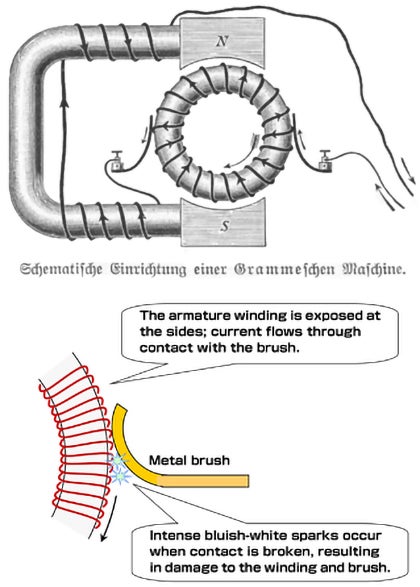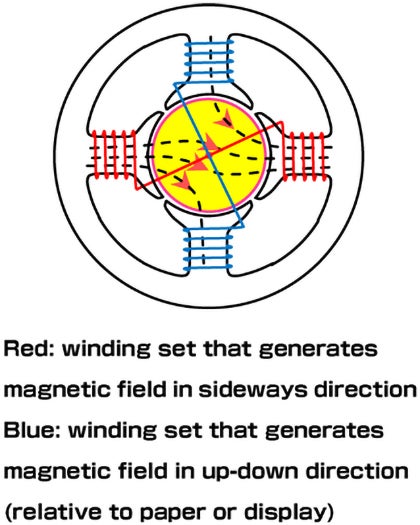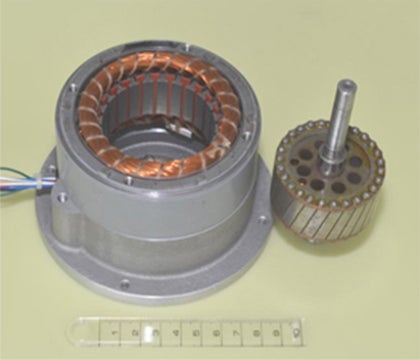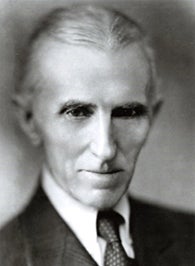Quest For Motors' Hidden Abilities and New Potentials
Lecture 1: Nikola Tesla and the Invention of the AC Motor
Among my publications, there is a book called ABCs of Motors (from Kodansha, a Japanese publishing company), although it is now out of print. In the foreword, I wrote about how I started writing this book in the second-class cabin of the Queen Mary. It was 1936 when this 81,000-ton luxury liner with a 2,000-passenger capacity went on its maiden voyage from Southampton to New York. I also wrote of having a conversation with the organizer of an academic conference in the first-class suite that had been used in the past by British Prime Minister Winston Churchill. My second-class cabin was also spacious and pleasant. This took place some twenty-five years ago, in 1987, when Queen Mary had long been decommissioned and converted to a hotel in Long Beach, California.
Many of the editors at the editorial conference of Kodansha's Blue Backs were negative about publishing this book due to their opinion that a book about compact motors would not sell well. Actually, however, it went through 20 printings, selling almost 60,000 copies. Compact motor technology was growing in Japan at that time. After ABCs of Motors, I wrote a more in-depth book on motors called Everything about Compact Motors (Gijutsu-Hyohron). It was first published in 2001.
I have written several academic papers on specific motor-related subjects but my name is better known to the general public through my specialized and general introduction books such as the above. In writing these books, I have often thought about the history of motor development, and have spent some time on this subject.In 1765, Watt invented the steam engine, which is also a type of motor, in England. As everyone now knows, this launched the industrial revolution. Later, Carnot (1824) of France and Lord Kelvin (1851) of England discovered important laws of thermodynamics. It was these achievements in the area of thermodynamics that enabled luxury liners fuelled by coal to embark on transatlantic voyages.
In more recent years, three notable events occurred in Japan in the 1980s. The first was the invention of the traveling-wave-type ultrasonic motor by Toshiiku Sashida. The second was the development of hard discs for magnetic recordings, which propelled the growth of technology of motors used to rotate the disc and those used to manipulate the magnetic head. The third involved the unified efforts of Japanese industry to apply vector control, which is said to have been proposed by a young German.
Moving devices symbolize the briskness of human and economic activities. It is the responsibility of industry to constantly refine and upgrade this technology. When I wrote ABCs of Motors in 1987, I was somewhat anxious about the apparent lack of interest in motor-related education at the university level. I think differently these days. I think university students should devote themselves to exploring the basics such as mathematics, physics, chemistry, etc., since it is difficult to learn these fields later in life. However, since the number of course hours and the quality of courses have been falling at Japanese universities over the past 30 years, highly motivated young people will have to make concerted efforts to overcome the existing environment. I think they should apply themselves to study practical subjects, from the basics to a somewhat advanced level, after they join a company. In doing so, the basic knowledge and ways of thinking they acquired during college will create results.
Nicola Tesla's greatness
The other day, I happened to meet and talk with Mr. Hattori, an executive officer of Nidec who has been leading the sales activities of Nidec since the establishment of the company. He said that the greatest inventor in the history of motor development must be Tesla. Well, he must be right.
I will now touch on Tesla.
I once read a biographical article on Tesla written by Dr. Sakae Yamamura, formerly a professor at the University of Tokyo, who contributed it to GAKUSHIKAIHO (the University Graduates' Society Journal). Professor Yamamura was said to be Japan's leading scientist in the area of motors. I met him at a private party where guests enjoyed Japanese cuisine to celebrate the publishing of his book by a British publisher. At the party, he said, "Kenjo-san, I won't write a textbook as you did."
In his book, he proposed the spiral vector theory, mostly targeted at motor specialists, which is not unrelated to Tesla's rotating magnetic field. In any case, I found his biography of Tesla very interesting. But what struck me was Tesla's autobiography,[1] which conveys the intensity and zeal of a man who wanted to be an inventor at any cost. My column introduces a very abridged biography of Tesla.
It appears that Tesla had the ability to memorize entire books. What is interesting is the story of how Tesla hit upon the idea of the induction motor as he was reciting a verse of the "Sunset Speech" from Goethe's Faust while strolling through a Budapest park with a friend. This was in 1882. Let us now imagine what this idea was like.
Inspired by the Gramme motor

The Gramme motor/generator that Tesla saw while attending the Graz Institute of Technology had a construction like the one shown in Fig. 1 . The stator consisted of a horse-shoe magnet and the rotor was a ring-type armature. To use it as a motor, electric current is supplied to the armature through the brushes. As the rotor turns, intense sparking occurs when the brush loses contact with the winding at the ring's side. Sparking occurs as long as a mechanical switching mechanism is used. Although the leading scientists of the day tried to construct a DC motor with no mechanical contact, they came to the conclusion that this was impossible and akin to making a perpetual motion machine. Some inventors are still trying to solve this problem today.
Tesla came up with the notion of using alternating current, but this did not come about easily. The idea that he came up with while in Budapest is likely to have had a cross-section construction such as the one shown in Fig. 2 .The device to generate the magnetic field required to create torque is called the field winding, of which the dc motor has a single set. The motor of Fig. 2 has two sets: one in red and the other in blue. The red set is supplied with a sinusoidal current that varies by a cosine function, and the blue set with a current that varies according to a sine function, as shown in Fig. 3 . Then, the magnetic field passing through the cylindrical rotor rotates. I can just imagine Tesla seeing in his mind the rotor with its rotating magnetic field against the backdrop of the Budapest setting sun.

This is the principle of creating a rotating magnetic field without moving the electromagnet. It was already known at the time that, when the magnet is moved, a metal such as copper will move due to the magnetic force, or in the case of a rotor with winding, that an electric current will flow from Faraday's law. If a rotating magnetic field could be created according to the principle conceived by Tesla, then it meant the invention of a new type of motor. He privately built a prototype of the induction motor and ran it successfully in Strasbourg in 1883, but was unable to garner sufficient interest.
Tesla’s epoch-making invention was put into practical service after he had moved to the United States. Subsequently, efforts to improve the design was taken up by scientists and engineers around the world, which led to the distributed-winding stator and squirrel-cage rotor common today and shown in Fig. 4 .


Meeting challenges to create new ideas
During a short trip to Budapest, I visited the apartment where Liszt, the famous pianist and composer, used to live. I then wondered if Tesla's apartment where he suffered a nervous breakdown might have been like this one, and imagined if the park I strolled in beside the Danube could have been the place where Tesla was hit with a revelation. No inspiration came to me, and it dawned on me that I was just an ordinary man.
When I learned about the principle of the motor based on the rotating magnetic field generated by applying alternating current to two sets of windings, as a junior in university, I was impressed by the inventor who had come up with this idea. But this was a textbook description which explained the invention in an easy-to-understand manner, after Tesla had invented it many years before. (Perhaps this is why Dr. Yamamura stated that he was not interested in writing textbooks!) Understanding an idea conceived earlier by some person and inventing something after agonizing through a lengthy period of trial and error are very different things, which is easily said but difficult to truly know.
I must explain the background to the scheme I came up with, shown in Fig. 2 After returning from my trip to Budapest, I spent nearly five years preparing for a book on dc motors by researching old documents, making prototypes, conducting experiments, and discussing issues with various experts. Three years later, when I was preparing training material for beginners who hope to become motor specialists, I was examining the structural connection between the dc motor and ac motor (which is not found in textbooks). It was then that I realized what Tesla must have come up with. I had skimmed through Tesla's autobiography[1] when I first read it, without paying careful attention.Recently, I was able to look through his autobiography once again and found in it a photograph which seems to confirm that the construction he conceived of in Budapest was indeed something like the one in Fig. 2 .
I think what Japan really needs in the future is not A students or academic overachievers but people who are willing to tackle challenging problems, as Nikola Tesla did, with the goal of making new discoveries.
- [1] My Inventions: The Autobiography of Nikola Tesla, http://www.teslasautobiography.com/

Nikola Tesla was born in 1856 in Croatia. His father was a priest, and his mother was an inventor. His mother and grandfather on his mother's side were both inventors. Deeply attracted by a rotation experiment involving leaf tin and using static electricity in a science class at the Real Gymnasium, an industrial school he entered at the age of ten, Tesla determined to become an electrical engineer instead of a priest, against his father's will.
Because of his unusually acute inborn sense and issues related to nervous depression, he hovered between life and death, but he overcame the disease by reading the works of Mark Twain that he discovered at a library.
He enrolled in Graz Institute of Technology in Austria. When he was a sophomore, he saw a Gramme DC motor delivered from Paris fail and emit sparks from the contact between the commutator and brush. As he was confident that he could invent a motor that did not emit sparks, he became engrossed in inventing motors. He quit the art and science course at Prague University in Bohemia before graduation and joined the Hungarian National Telecommunications Authority in Budapest. However, he developed a health issue in which he became able to acutely sense weak vibrations like a catfish does, which lead to psychological suffering. In an afternoon one day after he recovered from the symptoms in 1881, he was strolling through a park. He then started reciting a verse from Faust, in part because he was moved by the setting sun. It was at this moment when the idea of a rotating magnetic field motor using two-phase alternating current sprang into his mind like a divine revelation. Fig. 2 describes the principle of this motor.
Later on, he lived in Paris and worked for a company associated with Edison. A few years later, he verified the principle of alternating current motors using his own prototype in a factory in Strasbourg. In 1884, he went to America to improve a generator invented by Edison. Compared with Edison who was able to devote most of his youth to inventing without going to school, Tesla from time to time regretted having spent his time reading books at libraries in Europe and subsequently learnt a number of secondary languages.
Before long, he not only parted ways with Edison due to fundamental differences in thinking, but he also began feuding with him as a fierce competitor. While Edison was for direct-current power transmission, Tesla theoretically understood the advantage of using alternating current and subsequently invented a transformer.
Tesla developed a practical induction motor when Westinghouse launched their alternating current transmission business (circa 1887). He exhibited actual operation of a large-scale motor at the 1893 World Exposition held in Chicago.
During the development phase at Westinghouse, an alternating current of 133 Hz was used to run a motor. The current was reduced to 60 Hz as the motor speed was too fast. This is why 60 Hz frequency is used applied in the U.S. and western Japan today.
During the period when his invention was being developed, Tesla was often visited by Mark Twain, who became a great literary figure. When Tesla told Twain about having been saved by the latter's writing during his youth, the always smiling Twain suddenly burst out crying.

From ring-type armature to drum-type armature
From ring-type armature to drum-type armature The armature (rotor) of today's DC motors is mostly of the drum type, as shown in the photo. It was in 1876 that Hefner-Altenek first used this type of armature for a generator manufactured at Siemans and Halske. The drum-type armature made it easier to carry out the winding process, improved the electrical-to-mechanical energy conversion efficiency, and reduced sparking.